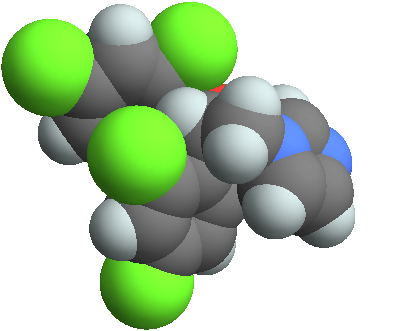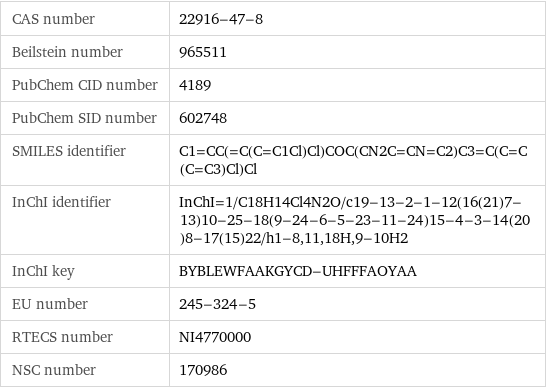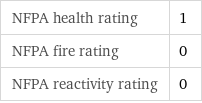Input interpretation

miconazole
Chemical names and formulas
![formula | C_18H_14Cl_4N_2O name | miconazole IUPAC name | 1-[2-(2, 4-dichlorophenyl)-2-[(2, 4-dichlorophenyl)methoxy]ethyl]imidazole alternate names | daktarin iV | minostate | monistat mass fractions | C (carbon) 52% | Cl (chlorine) 34.1% | H (hydrogen) 3.39% | N (nitrogen) 6.73% | O (oxygen) 3.84%](../image_source/af252ed863fb91dd560f00ed8b69b105.png)
formula | C_18H_14Cl_4N_2O name | miconazole IUPAC name | 1-[2-(2, 4-dichlorophenyl)-2-[(2, 4-dichlorophenyl)methoxy]ethyl]imidazole alternate names | daktarin iV | minostate | monistat mass fractions | C (carbon) 52% | Cl (chlorine) 34.1% | H (hydrogen) 3.39% | N (nitrogen) 6.73% | O (oxygen) 3.84%
Lewis structure

Draw the Lewis structure of miconazole. Start by drawing the overall structure of the molecule, ignoring potential double and triple bonds: Count the total valence electrons of the carbon (n_C, val = 4), chlorine (n_Cl, val = 7), hydrogen (n_H, val = 1), nitrogen (n_N, val = 5), and oxygen (n_O, val = 6) atoms: 18 n_C, val + 4 n_Cl, val + 14 n_H, val + 2 n_N, val + n_O, val = 130 Calculate the number of electrons needed to completely fill the valence shells for carbon (n_C, full = 8), chlorine (n_Cl, full = 8), hydrogen (n_H, full = 2), nitrogen (n_N, full = 8), and oxygen (n_O, full = 8): 18 n_C, full + 4 n_Cl, full + 14 n_H, full + 2 n_N, full + n_O, full = 228 Subtracting these two numbers shows that 228 - 130 = 98 bonding electrons are needed. Each bond has two electrons, so in addition to the 41 bonds already present in the diagram add 8 bonds. To minimize formal charge nitrogen wants 3 bonds and carbon wants 4 bonds. Identify the atoms that want additional bonds and the number of electrons remaining on each atom: Fill in the 8 bonds by pairing electrons between adjacent highlighted atoms. Note that the six atom rings are aromatic, so that the single and double bonds may be rearranged: Answer: | |
3D structure

3D structure
Basic properties

molar mass | 416.1 g/mol phase | solid (at STP) melting point | 135 °C solubility in water | insoluble
Units

Hydrophobicity and permeability properties

experimental LogP hydrophobicity | 6.1 predicted LogP hydrophobicity | 5.86 predicted LogS | -5.74
Drug interactions

acenocoumarol | anisindione | dicumarol | warfarin (total: 4)
Basic drug properties

approval status | approved | investigational | small molecule drug categories | antifungal agent dosage forms | topical: aerosol | intravaginal: cream | topical: cream | intravaginal: suppository

brand names | daktarin | femizol-M | M-zole 3 combination pack | M-zole 7 dual pack | micatin | miconazole 3 | miconazole 3 combination pack | miconazole 7 | miconazole 7 combination pack | miconazole nitrate | miconazole nitrate combination pack | miconazole-7 | micozole | minostate | monazole 7 | monistat | monistat 1 combination pack | monistat 3 | monistat 3 combination pack | monistat 3 dual-pak | monistat 3 vaginal ovules | monistat 5 | monistat 5 tampon | monistat 7 | monistat 7 combination pack | monistat 7 dual-pak | monistat 7 vaginal suppositories | monistat dual- PAK | monistat IV | monistat-3 combination pack | monistat-derm | novo-miconazole vaginal ovules | vusion | zimycan
Chemical identifiers

CAS number | 22916-47-8 Beilstein number | 965511 PubChem CID number | 4189 PubChem SID number | 602748 SMILES identifier | C1=CC(=C(C=C1Cl)Cl)COC(CN2C=CN=C2)C3=C(C=C(C=C3)Cl)Cl InChI identifier | InChI=1/C18H14Cl4N2O/c19-13-2-1-12(16(21)7-13)10-25-18(9-24-6-5-23-11-24)15-4-3-14(20)8-17(15)22/h1-8, 11, 18H, 9-10H2 InChI key | BYBLEWFAAKGYCD-UHFFFAOYAA EU number | 245-324-5 RTECS number | NI4770000 NSC number | 170986
NFPA label

NFPA label

NFPA health rating | 1 NFPA fire rating | 0 NFPA reactivity rating | 0
Toxicity properties

RTECS classes | drug | mutagen | reproductive effector | human data